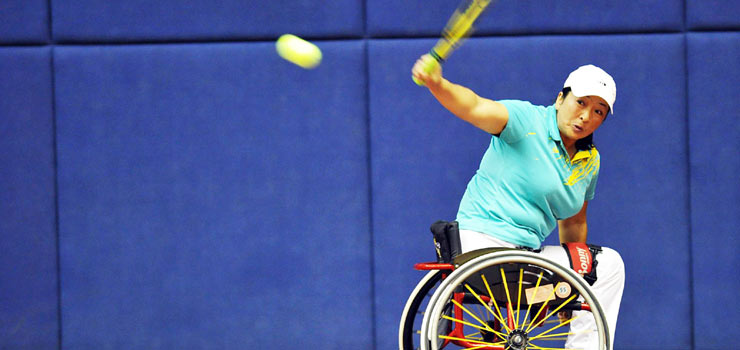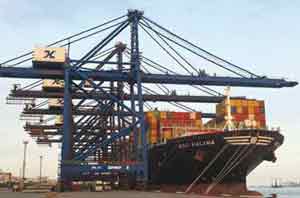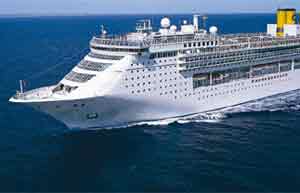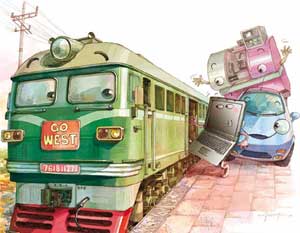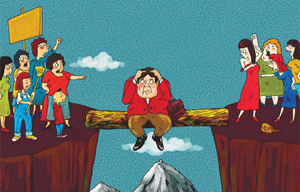The commercial pull in a china shop
Updated: 2011-10-28 10:53
By Wang Chao (China Daily European Weekly)
|
|||||||||
An old craft gets a modern touch to attract tourists
In 1920 when the American journalist William Chaplin visited Jingdezhen, Jiangxi province, he was astonished by the countless chimneys with black smoke, emitting from the porcelain kilns.
He wrote: "I counted that there are 78 chimneys, but this is only a small fraction. At its prime time, there were several hundred kilns in Jingdezhen."
|
 Jingdezhen Ceramics Co expects monthly tourism revenue to reach 1 million yuan next year. [Wang Chao / China Daily] |
That scene is gone forever, most coal-fired kilns having been replaced by gas kilns or production lines. At Jingdezhen Ceramics Co Ltd, a State-owned company that produces porcelain tableware, only a few workers work in the spacious plant.
Jingdezhen is changing from a polluted industrial city to a tourism destination, says the city's mayor, Liu Changlin, adding that the city is being promoted as "the green capital of porcelain".
As a household name for making porcelain, it is now being transformed into a tourist destination.
Last year the ceramic industry contributed 16 billion yuan ($2.5 billion, 1.8 billion euros) to the city, 35 percent of local gross domestic product, followed by tourism at 6.7 billion yuan, double what it was five years earlier.
The city pulled in 5.4 billion yuan from tourism revenue in the first seven months of this year, a year-on-year increase of 41 percent. Among the 10 million tourists who visited, 149,800 came from abroad, up 21 percent on the previous year, official figures show.
"Jingdezhen porcelain is among the best known brands in China, and we should tap the full potential from it," Liu says. With little to boast about apart from ceramics, he says, that is what its campaign to attract tourists should center on.
Jingdezhen, located in East China, counts several popular travel destinations among its neighbors. Huangshan Mountain, Lushan Mountain, the ancient town of Wuyuan and Poyang Lake are all within a four-hour drive.
Every year thousands of tourists visiting these scenic spots head for Jingdezhen, buying porcelain products including tableware, flower vases and ceramics paintings.
The city has recently signed agreements with neighboring cities to jointly promote regional tourism, focusing on porcelain and natural scenery.
However, Jingdezhen is not content to hang on the coat tails of others and wants to have some tourists it can call its own.
The city has a good example to follow. Ichon city in South Korea has started to develop ceramics tourism by introducing pottery-making studios, museums and entertainment related to ceramics. That strategy is drawing a rising number of tourists to the city.
Wang Yao, president of Jingdezhen Ceramic Co Ltd, says his company is doing its bit to help the city in its tourism drive. "People want to know how porcelain products are made, and how to distinguish boutiques from copycats, so we have thrown open the door to give them a chance to see that."
Since 2009 the company has revamped the production line, allowing visitors to view what is going on. "In Jingdezhen, many small workshops make traditional porcelain; here they can look at the modern process of making ceramics."
Apart from the automated production line, there is a handcraft room in which artists paint traditional patterns on clay and shape pots on wheels.
When the company started marketing this ceramic tourism, monthly revenue was 30,000 yuan ($4,700, 3,400 euros), but now "we are taking in half a million every month, and I think the number will reach 1 million next year".
But many companies are not paying enough attention to ceramics tourism, Wang says.
"Since revenue directly from tourists is just a fraction of total revenue, many companies don't take it too seriously. But things should be seen with a longer perspective: Today's tourists can be tomorrow's consumers.
"These tourists would be able to promote Jingdezhen products to more potential consumers, and the advertising effect would be invaluable."
The company has signed contracts with more than 20 travel agencies offering them incentives to send tourists to the city.
Mao Peiqi, a professor in the history department at Renmin University of China in Beijing, says preserving culture is the key element in developing tourism in Jingdezhen.
"I'm strongly against any idea of creating artificial scenery in the old city, which will destroy precious legacies. A place that best preserves things untouched has the most appeal. I have heard that 50 percent of Jingdezhen residents still make a living from porcelain. So the city can attract many tourists just by showing their real lives."



